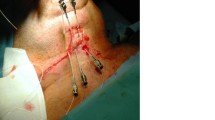Abstract
Head and neck cancer treatment includes a multidisciplinary approach involving all specialties. Surgery and radiotherapy are equally effective in controlling small tumors. Intensity-modulated radiotherapy (IMRT) and interstitial brachytherapy (ISBT) play an important role in the treatment of head and neck cancers. Both are proved to be highly conformal techniques of radiotherapy. Our aim is to compare dosimetric aspects of ISBT alone, IMRT alone, and IMRT combined with ISBT in early stage node negative oral cavity cancer. Ten cases of histopathologically proven early stage node negative oral cavity cancer were treated with external beam therapy followed by interstitial brachytherapy boost or ISBT alone. All these patients had undergone computerized tomography (CT) planning for brachytherapy. Retrospectively, these images were utilized, and three sets of plans were done for each patient’s CT image set. Group A was IMRT alone plans, groups B had combined IMRT with ISBT boost, and group C was ISBT alone plans. Dosimetric details such as target coverage, dose to critical organs, and conformity index were compared between the three sets of plans. The mean values of the doses to the critical organs with IMRT alone and IMRT with ISBT boost were brainstem 10.40 Gy and 9.20 Gy, spinal cord 19.20 Gy and 16.10 Gy, mandible 62.99 Gy and 66.50 Gy, and I/L and C/L parotids were 6.03 Gy and 5.50 Gy and 5.70 Gy and 5.10 Gy where as in ISBT alone plans mean values were brainstem 1.30 Gy, spinal cord 1.40 Gy, mandible 36.50 Gy, I/L, and C/L parotids were 1.60 Gy and 1.00 Gy. Conformity index (CI) between IMRT and ISBT plans were 0.8580 and 0.7140 respectively. With comparable CI values, doses to critical organs appear to be in favor of ISBT plans as opposed to IMRT, and this was found to be statistically significant. Brachytherapy shows a dosimetric advantage over IMRT in this setting and could be translated to a benefit in terms of toxicities, organ preservation, and cosmesis in the actual clinical scenario. However, whether this would translate to significant benefit in terms of clinical outcome needs to be still verified.





Similar content being viewed by others
References
Mazeron JJ, Ardiet JM, Haie-Meder C et al (2009) GEC-ESTRO recommendations for brachytherapy for head and neck squamous cell carcinomas. Radiother Oncol 91:150–156
Umeda M, Komatsubara H, Ojima Y, Minamikawa T, Shibuya Y, Yokoo S, Ishii J, Komori T (2005) A comparison of brachytherapy and surgery for the treatment of stage I-II squamous cell carcinoma of the tongue. Int J Oral Maxillofac Surg 34:739–744
Eisbruch A, Levendag PC, Feng FY, Teguh D, Lyden T, Schmitz PIM, Haxer M, Noever I, Chepeha DB, Heijmen BJ (2007) Can IMRT or brachytherapy reduce dysphagia associated with chemoradiotherapy of head and neck cancer? The Michigan and Rotterdam experiences. Int J Radiat Oncol Biol Phys 69(2 Suppl):S40–S42
Sresty NV, Ramanjappa T, Raju AK, Muralidhar KR, Sudarshan G (2010) Acquisition of equal or better planning results with interstitial brachytherapy when compared with intensity-modulated radio therapy in tongue cancers. Brachytherapy 9:235–238
Author information
Authors and Affiliations
Corresponding author
Additional information
Publisher’s Note
Springer Nature remains neutral with regard to jurisdictional claims in published maps and institutional affiliations.
Rights and permissions
About this article
Cite this article
Alva, R.C., Koushik, A.S.K., Sweta, B. et al. Brachytherapy for Oral Cavity Cancers in the Era of Intensity-Modulated Radiotherapy: Save it or Shelve it. Indian J Surg Oncol 11, 406–411 (2020). https://doi.org/10.1007/s13193-020-01075-w
Received:
Accepted:
Published:
Issue Date:
DOI: https://doi.org/10.1007/s13193-020-01075-w




